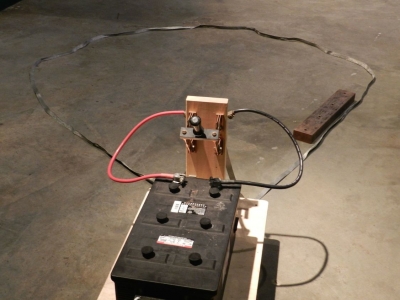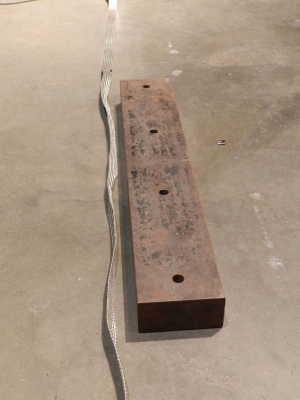An image current is created in a ferromagnetic material in the presence of a real current.
What It Shows:
The demonstration is a realization of problem 5.17 in J.D. Jackson's Classical Electrodynamics, 3rd ed, (John Wiley & Sons, 1999) p.229. To paraphrase, if there is a current adjacent to a semi-infinite slab of material having a relative permeability μ, then mathematically the behavior of the material is as if there were an image current distribution of magnitude (μ-1)/(μ+1) times the current J inside the material.
How it works:
A braided copper conductor is laid down alongside a 2"×4"×24" iron bar with approximately 1" separation between the two. A truck battery serves as the current source. When the circuit is momentarily completed, the copper conductor is attracted to the iron bar (they actually come in contact). The behavior is as if there is a current flowing in the iron bar in the same direction as the current in the copper conductor. The attraction is not a transitory effect. If the switch remains closed for about 1½ seconds, the conductor is attracted the entire time. When the switch is opened, it clearly "relaxes" away from the iron bar.
There must also be an induced eddy current in the magnetic material, but evidently this eddy current is weaker than the image current. If you perform this experiment with a large bar of copper, then the braided copper wire is repelled from the copper bar. Since copper is an excellent conductor (compared to iron), the eddy current repulsive effect dominates.
Mathematics aside, what's really going on? We think that the magnetic field produced by the electrical current aligns the magnetic dipoles of the magnetic material and these aligned dipoles create a magnetic field that then attracts the electrical current (Lorentz force). Apparently the magnetic field configurations of this complicated situation appears to be identical to those created by two currents flowing in the same direction—the electric current outside the magnetic material and an image current inside the magnetic material.


Setting it up:
The smooth cement floor of the lecture hall is ideal for this demo. The friction is small enough so as not to overwhelm the magnetic attraction.
Comments:
The 1 inch-wide copper braid cable plus knife switch resistance is 9 mΩ. With a 12 V truck battery, we're talking 1300 amperes. It's probably closer to 1000 amp, taking the internal (estimated) resistance of the battery into account.

